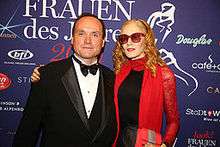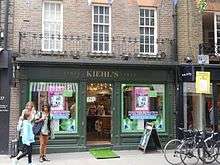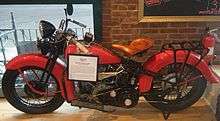Kiehl's
 | |
| Limited liability company | |
| Industry | Personal care |
| Founded | 1851 |
| Founder | John Kiehl |
| Headquarters | 3rd Avenue, Manhattan, New York City, U.S. |
Area served | Worldwide |
Key people |
|
| Products | Cosmetics |
| Parent | L'Oréal |
| Website | kiehls.com |
Kiehl's is an American cosmetics brand retailer that specializes in premium skin, hair, and body care products. It started as a single pharmacy in Manhattan at Third Avenue and East 13th Street in 1851. Kiehl's was purchased by the L'Oréal Group in 2000 and currently has more than 250 retail stores worldwide, and over 1,000 points of sale supplemented by sales in high-end department stores, select airport locations, as well as independent stockists. In contrast to its market competitors, Kiehl's is distinguished for its unorthodox marketing approach, exceptionally large male clientele base, and its products' simple and straightforward packaging.
History
Foundation


Founded in 1851 by John Kiehl, Kiehl's began as a homeopathic pharmacy located at 3rd Avenue and 13th Street in the East Village of New York City. In 1921, Irving Morse, a former apprentice and Russian Jewish émigré who had studied pharmacology at Columbia University, purchased the store. Morse was involved in the development of many Kiehl's products that are still popular today, including Blue Astringent Herbal Lotion and Creme de Corps.[1][2]
Irving's son, Aaron Morse, who also studied pharmacology at Columbia University and was a former World War II pilot, took over the store in the 1960s. The younger Morse was credited for propelling Kiehl's from obscurity in the 1950s to international recognition as an upscale natural cosmetics shop in the 1980s.[1][2] Aaron transitioned the store from the traditional pharmaceuticals his father preferred to develop skin care lines. After he died in 1995, his desk and some of his vintage motorcycles were prominently showcased in the store.[2]
By then, Aaron's daughter, Jami Morse Heidegger, had been operating the business since 1988. Described as "a clever marketer," she relied on word of mouth and extensive free samples and gifts to market Kiehl's products, rather than traditional advertising.[1]
Acquisition by L'Oréal
In April 2000, the French beauty and cosmetics company L'Oréal acquired Kiehl's for between $100–$150 million. L'Oréal had pursued the purchase of the company for more than two years but the real catalyst for a deal came when Kiehl's had difficulty handling the growing volume of orders due to the company's growing popularity. Morse Heidegger, then president of Kiehl's, said, "We took a long hard look at the situation, and we felt that in order to keep up with the demand, in order to not be out of stock, in order to fulfill our destiny, if you will, we needed to take on a partner."[3]
With the purchase, L'Oréal stated it planned "to increase the brand's presence but maintain it as a luxury line rather than a mass-market one." Kiehl's would also be expanded internationally.[3] At the same time, Kiehl's newly appointed president Michelle Taylor said, "The thing most important to me is to keep Kiehl's true to what it is. Respect for old-fashioned values is really who we are."[4]
Business
Stores


For the first 150 years of the company, Kiehl's only ran one store with its products also selling in high-end department stores such as Neiman Marcus, Barneys, Bergdorf Goodman, Saks Fifth Avenue and Harvey Nichols.[5] Following its acquisition by L'Oréal though, the company expanded from its one Manhattan flagship store to more than 30 stores today.[6] Kiehl's sales have also more than quadrupled, increasing from $40 million in 2000 to past $200 million in 2009.[7]
Kiehl's original store, located at 3rd Avenue and 13th Street in the East Village of Manhattan, occupies the same space as when it was founded in 1851.[1] The site of Kiehl's location is known as "Pear Tree Corner" for the pear tree Peter Stuyvesant, governor of the Dutch colony New Amsterdam, planted there in 1647.[8] A wagon collision felled the tree in 1867; it was then known as "the oldest living thing in the city of New York."[9] In November 2003, Kiehl's initiated the replanting of a new pear tree in its spot.[10] Today, the store has evolved into a neighborhood institution; Frommer's 2010 New York City travel guide states "Kiehl's is more than a store, it's a virtual cult."[11] Distinguishing features of the store include its window display of vintage druggist relics, and the collection of classic Harley-Davidson and Indian motorcycles housed within its doors.[1][12]
Products and sales
Compared to its competitors, Kiehl's states that it spends three to five more times on its upscale natural cosmetic products. At the same time, Kiehl's merchandise is "priced at the lower end of prestige skin care" while being distinguished for its simple and straightforward packing "which speaks to the old apothecary concept."[4] To this day, Kiehl's signature products, such as its night cream, calendula toner, Blue Astringent,[13] Creme de Corps[14] and Original Musk Oil,[15] continue to remain customer favorites.
To market its products, Kiehl's applies a non-traditional marketing approach that "relies heavily on free product samples, word of mouth endorsements from existing customers, and innovative marketing techniques."[16] Particularly known for its generous sampling policy, "Kiehl's gave away more than 12 million samples a year, which represents 80 percent of their total marketing budget" according to Lynn Upshaw in Truth: The New Rules for Marketing in a Skeptical World. Upshaw writes, "The Kiehl's way of 'selling' is not to sell at all… They believe the products will do what they do and no hype will change that."[17] Donations, most prominently in charity event gift bags, also attract customers.[4]
On a local store level, Kiehl's works to understand each new location and develop a unique approach for that market. For example, for the opening a new store in New York's Upper West Side, Kiehl's supported improvements to a local playground in Central Park, a hot community topic at the time.[16][18] Within the stores, Kiehl's is known for its focus on customer service and its "retail brand experience." Their lab-coated staff undergoes an "intensive four-week residency schooling that drills them in the chemistry, use and application of Kiehl's products."[19]
Clientele

Allan Mottus, the editor of the cosmetics industry magazine The Informationist, stated, "The Kiehl's store always attracted a cutting-edge younger-crowd."[4] Compared to other cosmetics stores, Kiehl's is also known for appealing to an exceptionally large male clientele, which represents 30 to 40 percent of the company's customer base.[20] In cities like New York and Los Angeles, nearly half of all customers are men. According to Wendy Liebmann, chief executive of New York research firm WSL Strategic Retail, "Kiehl's changes the paradigm with a health and wellness approach that demystifies cosmetics. There's no intimidating hocus-pocus. It feels authentic and fun."[7]
Philanthropy
Kiehl's is recognized for its philanthropic activities. More than 40 years ago, Aaron Morse wrote the "Mission of Kiehl's," a 137-word statement which committed the company to the objective of "making for better citizens, better firms, and better communities."[21][22] Today, the cosmetics retailer is focused on three primary philanthropic causes: AIDS research and prevention, children's well-being and the environment.[21] Kiehl's stores have also begun to regularly host pet adoption events.[23] In August 2010, the company launched its inaugural "Kiehl's Liferide for amfAR" (The Foundation for AIDS Research). At the end of the six-day charitable motorcycle ride up the coast of California, Chris Salgardo, the President of Kiehl's USA who led the group on his own Harley-Davidson, presented an $85,000 check to amfAR.[7][24]
References
- 1 2 3 4 5 Mike Albo (18 January 2007). "Critical Shopper; Grand Old Apothecary, Version 2.0". The New York Times.
- 1 2 3 Monte Williams (7 May 1995). "Neighborhood Report: East Side; Farewell To the Man Behind Kiehl's". The New York Times.
- 1 2 Constance L. Hays (18 April 2000). "Kiehl's Cosmetics Company Bought by France's L'Oreal". The New York Times.
- 1 2 3 4 Alex Witchel (12 August 2001). "Counterintelligence; New Owners Let Kiehl's Be Kiehl's". The New York Times.
- ↑ Heather Chaplin (1 July 2000). "Selling Out Trendy Kiehl's was the ultimate family firm. So why the heck cash out?". CNN.
- ↑ Joyce Smith (17 August 2010). "Kiehl’s opens store within a store at Dillard's in Independence". Kansas City Star.
- 1 2 3 Mark Albright (17 August 2010). "Kiehl's makes inroads into elusive male cosmetics market". St. Petersburg Times.
- ↑ "1867: Pear Tree Corner". Kiehl's. Retrieved 23 August 2010.
- ↑ Jim O'Grady (9 November 2003). "A New Pear Tree Will Pay Homage to Old New York". The New York Times.
- ↑ "‘Stuyvesant’s pear tree’ replanted on 13th St.". The Villager. 19–25 November 2003.
- ↑ "Kiehl’s". Frommer's. The New York Times. 2010. Archived from the original on 16 June 2009. Retrieved 23 August 2010.
- ↑ "The 100+ Vintage Motorcycle Collection!". Kiehl's. Retrieved 23 August 2010.
- ↑ "1964:The Blue Stuff!". Kiehl's. Retrieved 23 August 2010.
- ↑ "1970s: 'A Rich, Buttery Performance!'". Kiehl's. Retrieved 23 August 2010.
- ↑ "1958: Love Oil is Discovered". Kiehl's. Retrieved 23 August 2010.
- 1 2 Deirdre Sullivan (10 April 2006). "Kiehl's executive reveals secrets of guerrilla marketing to fashion club". The Wharton Journal. Archived from the original on 10 February 2010.
- ↑ Upshaw, Lynn B. (2007). Truth: The New Rules for Marketing in a Skeptical World. New York, NY: AMACOM. p. 48. ISBN 978-0-8144-7376-4. Retrieved 23 August 2010.
- ↑ Upshaw. Truth: The New Rules for Marketing in a Skeptical World. p. 48. Retrieved 23 August 2010.
- ↑ Upshaw. Truth: The New Rules for Marketing in a Skeptical World. p. 47. Retrieved 23 August 2010.
- ↑ Upshaw. Truth: The New Rules for Marketing in a Skeptical World. p. 49. Retrieved 23 August 2010.
- 1 2 "Kiehl’s in the Community". Kiehl's. Retrieved 23 August 2010.
- ↑ "Kiehl's Since 1851, Inc.". Funding Universe. Retrieved 23 August 2010.
- ↑ Emili Vesilind (28 February 2010). "Kiehl's hosts the first of many animal adoption events on Robertson Boulevard". Los Angeles Times.
- ↑ Rachael Kelley (16 August 2010). "Motorcycles: Celebrity 'Life Ride'". Ultimate MotorCycling.
Further reading
- Manmade: The Essential Skincare & Grooming Reference for Every Man Chris Salgardo, president of Kiehl’s United States. Published 2016.